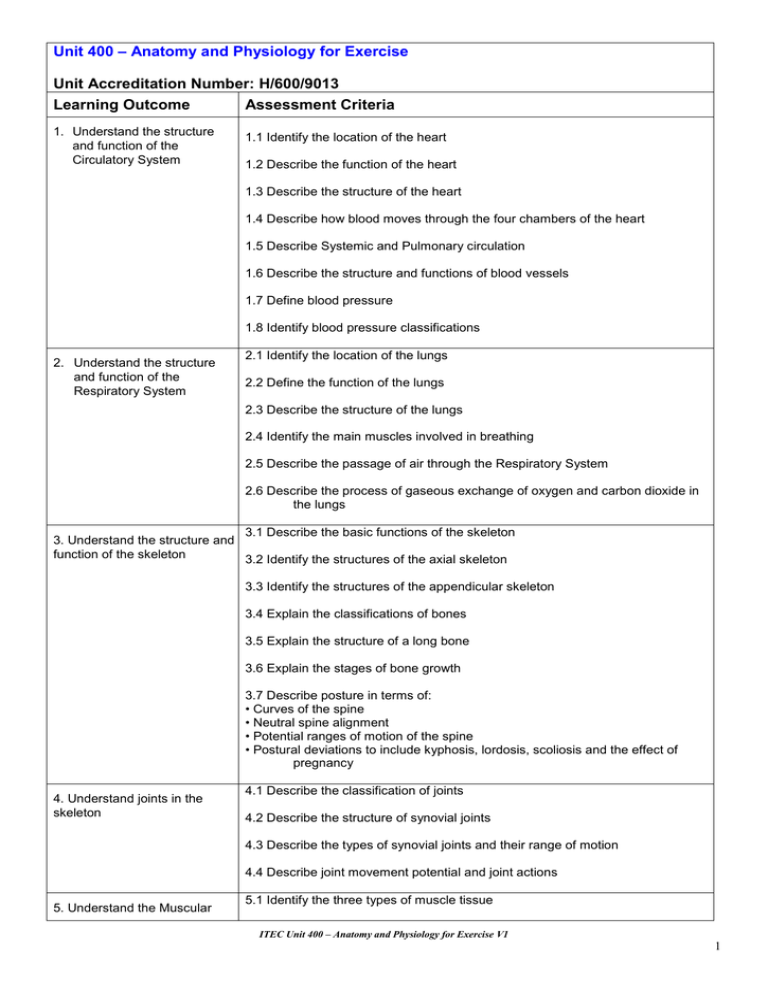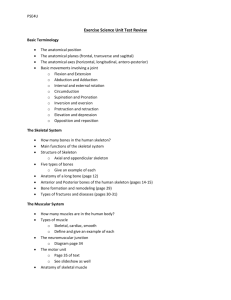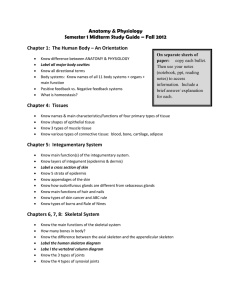– Anatomy and Physiology for Exercise Unit 400 Unit Accreditation Number: H/600/9013
advertisement

Unit 400 – Anatomy and Physiology for Exercise Unit Accreditation Number: H/600/9013 Learning Outcome Assessment Criteria 1. Understand the structure and function of the Circulatory System 1.1 Identify the location of the heart 1.2 Describe the function of the heart 1.3 Describe the structure of the heart 1.4 Describe how blood moves through the four chambers of the heart 1.5 Describe Systemic and Pulmonary circulation 1.6 Describe the structure and functions of blood vessels 1.7 Define blood pressure 1.8 Identify blood pressure classifications 2. Understand the structure and function of the Respiratory System 2.1 Identify the location of the lungs 2.2 Define the function of the lungs 2.3 Describe the structure of the lungs 2.4 Identify the main muscles involved in breathing 2.5 Describe the passage of air through the Respiratory System 2.6 Describe the process of gaseous exchange of oxygen and carbon dioxide in the lungs 3.1 Describe the basic functions of the skeleton 3. Understand the structure and function of the skeleton 3.2 Identify the structures of the axial skeleton 3.3 Identify the structures of the appendicular skeleton 3.4 Explain the classifications of bones 3.5 Explain the structure of a long bone 3.6 Explain the stages of bone growth 3.7 Describe posture in terms of: • Curves of the spine • Neutral spine alignment • Potential ranges of motion of the spine • Postural deviations to include kyphosis, lordosis, scoliosis and the effect of pregnancy 4. Understand joints in the skeleton 4.1 Describe the classification of joints 4.2 Describe the structure of synovial joints 4.3 Describe the types of synovial joints and their range of motion 4.4 Describe joint movement potential and joint actions 5. Understand the Muscular 5.1 Identify the three types of muscle tissue ITEC Unit 400 – Anatomy and Physiology for Exercise V1 1 5.2 Define the characteristics and functions of the three types of muscle tissue System 5.3 Describe the basic structure of skeletal muscle 5.4 Name and locate the anterior skeletal muscles 5.5 Name and locate the posterior skeletal muscles: 5.6 Describe the structure and function of the pelvic floor muscles 5.7 Describe the different types of muscle action 5.8 Identify the joint actions brought about by specific muscle group actions 5.9 Identify skeletal muscle fibre types and their characteristics 6.1 Describe the life-course of the Musculoskeletal System, and its implications 6. Understand the life-course of for working with: the Musculoskeletal System • Young people in the 14 -16 age range and its implications for special • Antenatal and postnatal women populations exercise • Older people (50 plus) To include relevant tendon, ligament, muscle, joint and bone mineral density changes and their implications for exercise 7.1 Describe how carbohydrates, fats and proteins are used in the production of 7. Understand energy systems energy/adenosine triphosphate and their relation to exercise 8 Understand the Nervous System and its relation to exercise 7.2 Explain the use of the three energy systems during aerobic and anaerobic exercise 8.1 Describe the role and functions of the Nervous System 8.2 Describe the principles of muscle contraction 8.3 Describe the ‘all-or-none law’/motor unit recruitment 8.4 Describe how exercise can enhance neuromuscular connections and improve motor fitness Assessment method: MCQ Date: ................. Unit complete: Date.................. Signed by the Lecturer/Assessor Signed by the Candidate ----------------------------------------------- ---------------------------------------- Quality Assured By: Name: Signature: Date: ITEC Examiner/External Verifier Name: Signature: Date: ITEC Unit 400 – Anatomy and Physiology for Exercise V1 2







